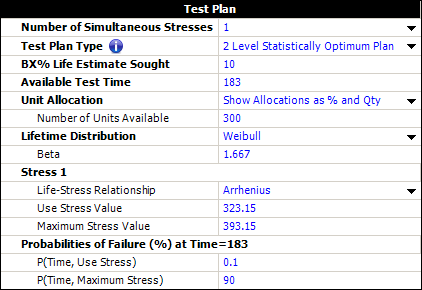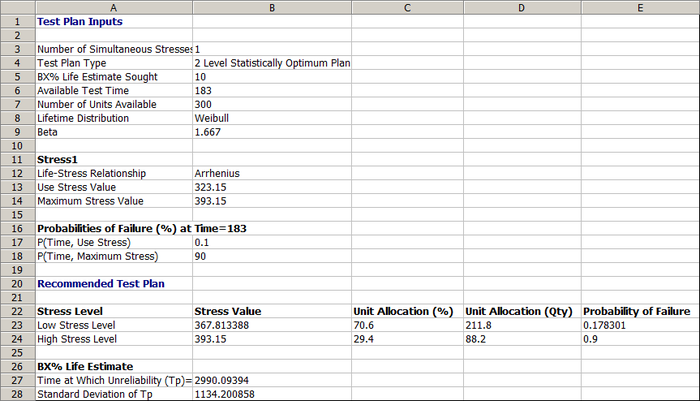Two Level Optimum Test Plan for One Stress: Difference between revisions
Jump to navigation
Jump to search
Kate Racaza (talk | contribs) No edit summary |
Kate Racaza (talk | contribs) No edit summary |
||
| (5 intermediate revisions by the same user not shown) | |||
| Line 1: | Line 1: | ||
{{Reference Example| | {{Reference Example|{{Banner ALTA Reference Examples}}}} | ||
This example | This example validates the results for the 2 level statistically optimum test plan for one stress in ALTA. | ||
| Line 11: | Line 11: | ||
{{Reference_Example_Heading2}} | {{Reference_Example_Heading2}} | ||
A Weibull distribution with an Arrhenius life stress relationship is used. The Arrhenius relationship uses the following formula: | A Weibull distribution with an Arrhenius life-stress relationship is used. The Arrhenius relationship uses the following formula: | ||
| Line 23: | Line 23: | ||
A total of 300 units are available for testing. The objectives of the test plan are to: | A total of 300 units are available for testing. The objectives of the test plan are to: | ||
* Determine the two temperature levels that | * Determine the two temperature levels that should be used in the test. | ||
* Determine the number of test units at each temperature level. | * Determine the number of test units at each temperature level. | ||
| Line 31: | Line 31: | ||
{{Reference_Example_Heading3}} | {{Reference_Example_Heading3}} | ||
The | The 2 level statistically optimum test plan is: | ||
* 212 units should be tested at 95°C (368.15 °K) | * 212 units should be tested at 95°C (368.15 °K) | ||
* 88 units should be tested at 120°C (393.15 °K). | * 88 units should be tested at 120°C (393.15 °K). | ||
| Line 46: | Line 46: | ||
The resulting | The resulting test plan in ALTA is shown below. | ||
[[Image: Optimum plan one stress test plan.png|center|700 px]] | [[Image: Optimum plan one stress test plan.png|center|700 px]] | ||
This test plan shows that (starting at row 23 in the picture above): | |||
* The low stress level | * The low stress level should be 367.8°K (94.65°C) and about 212 units should be tested at this temperature. | ||
* The high stress level | * The high stress level should be 393.15°K (120°C) and about 88 units should be tested at this temperature. | ||
The results above are the same as the results given in the book. | The results above are the same as the results given in the book. | ||
The estimated standard deviation of the log B10 life at 50°C can be calculate | The estimated standard deviation of the log B10 life at 50°C can be calculate from the values given in the '''BX% Life Estimate''' area (row 26) of the results shown above. | ||
::<math>Ase\left[log \left(\hat{t}_{0.1}(50) \right) \right] = \frac{Ase\hat{t}_{0.1}(50)}{\hat{t}_{0.1}(50)} = \frac{1134.2}{2990.09} = 0.37932\,\!</math> | ::<math>Ase\left[log \left(\hat{t}_{0.1}(50) \right) \right] = \frac{Ase\left(\hat{t}_{0.1}(50)\right)}{\hat{t}_{0.1}(50)} = \frac{1134.2}{2990.09} = 0.37932\,\!</math> | ||
This is very close to the estimated standard deviation in the book. The difference is | This is very close to the estimated standard deviation in the book. The difference is likely due to rounding error. | ||
Latest revision as of 18:23, 28 September 2015
New format available! This reference is now available in a new format that offers faster page load, improved display for calculations and images and more targeted search.
As of January 2024, this Reliawiki page will not continue to be updated. Please update all links and bookmarks to the latest references at ALTA examples and ALTA reference examples.


